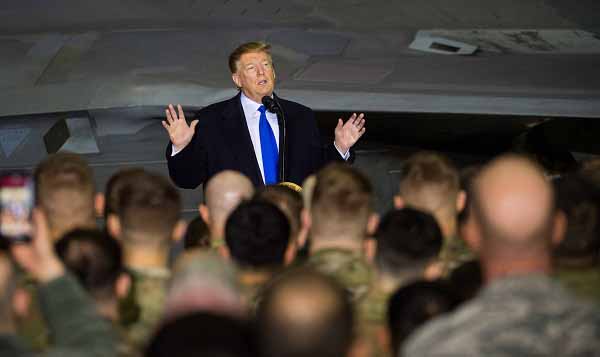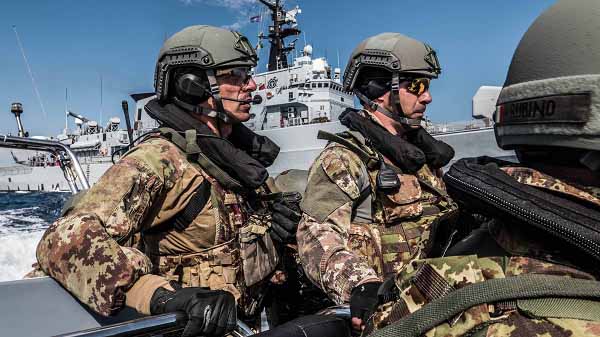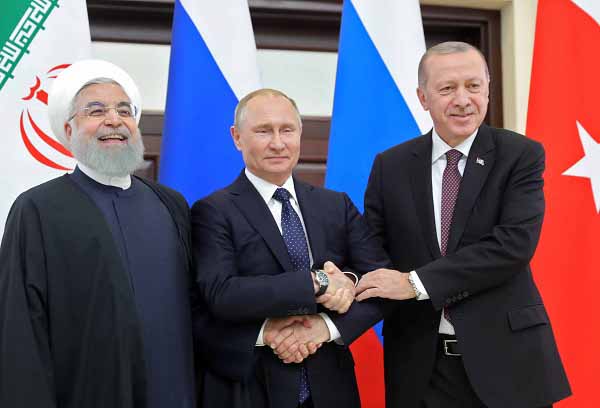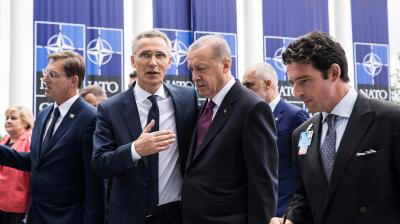70 Years of NATO
This article was originally published in the 'Militaire Spectator'
The resurgence of an external strategic threat has not resulted in a firmly united NATO. At its 70th anniversary in April 2019, the Alliance as the cornerstone of European security is crumbling under the combined weight of American President Trump, the East-South divide and Turkey.
After two decades of out-of-area operations, from the Balkans to Afghanistan, NATO has returned to its original core task: deterrence and territorial defence. Since the Russian annexation of the Crimea and the start of Moscow’s interference in eastern Ukraine in 2014, Article 5 has retaken its priority position in the Alliance’s list of main tasks.[fn]NATO has three main tasks: territorial defence (Article 5); crisis management (non-Article 5); and cooperation and partnerships. Since the Wales Summit (September 2014) the Alliance’s efforts to strengthen its deterrence and defence posture have focussed on the Article 5 task.[/fn] Russia’s assertive foreign policy, its military intervention in Syria, its chemical-poisoning of Sergei and Yulia Skripal in the United Kingdom, its intelligence service actions – in particular the intended cyber-attack on the headquarters of the Organisation for the Prohibition of Chemical Weapons (OPCW) in The Hague – have all underscored the need for a strong and credible Alliance, adapted to the security needs of the 21st century. So far, so good. Unfortunately, the resurgence of an external strategic threat has not resulted in a firmly united NATO. Three major internal issues are eroding the cohesion of the Trans-Atlantic Alliance at its 70th anniversary in April 2019: American President Donald Trump, the East-South divide and Turkey.[fn]This article is based on two other publications of the author: The Future of NATO – Strategic Monitor 2018-2019, Clingendael Report, 18 December 2018; Turkey and NATO – living apart together, Clingendael CrisisAlert 1, 29 January 2019.[/fn]
The Trump factor
"Since Donald Trump entered the White House a dark cloud has been hanging over the Trans-Atlantic relationship"
Since Donald Trump entered the White House a dark cloud has been hanging over the Trans-Atlantic relationship. With his ‘America First’ campaign he is primarily challenging Europe in terms of economic protection, by the withdrawal of the US from the Paris climate agreement and by stepping out of the Iran nuclear deal. Nevertheless, the security and defence relationship between the US and Europe has entered a new phase, too. Doubts have been cast on the US commitment to Europe’s security, despite repeated statements by other officials representing the American Administration in favour of NATO. Trump is no longer openly questioning the existence of the Alliance, but he has turned the burden-sharing issue into a key measurement tool for future US investment in Europe’s security. With his two sentences directed at former Defence Secretary Jim Mattis: “You can have your NATO. But you become the rent collector”,[fn]Bob Woodward, Fear. Trump in the White House (New York, Simon & Schuster, September 2018).[/fn] Trump has made this clear. European countries will be held accountable for realising the target of spending 2 percent of their GDP on defence, as was agreed at the NATO Summit in 2014. Bad performers can expect a barrage of tweets from the White House, if they do not show a credible national plan to realise the NATO target by 2024.[fn]The National Plan on the Defence Investment Pledge of the Netherlands was sent to NATO and the Dutch Parliament mid-December 2018. It announces additional financial resources for defence but contains no answer to the question if and how the Netherlands will realise the NATO 2 percent target.[/fn]
Trump will continue to connect the issue to the bilateral trade balance and other topics, judging NATO countries individually. Never before has an American President been so critical about key European partners such as Germany. Never before have staunch supporters of the Trans-Atlantic link questioned the US commitment to Europe’s security. According to a 2018 poll 56 percent of Germans thought that German-US relations were in a bad shape and only 11 percent had confidence in the US President – in contrast with the 86 percent in the last year of President Barack Obama’s tenure.[fn]Dorothy Manevich and Richard Wike, Americans Say U.S.-German Relations Are in Good Shape, but Germans Disagree (Washington, D.C., PEW Research Center, February 2018).[/fn] French President Emmanuel Macron’s relationship with Trump can be characterised by its ups and downs; the latter may also be credited for his own calls for a European Army.[fn]Such as on the eve of the ceremonies to commemorate the end of World War I. See: Julian Borger, ‘Trump says Macron’s call for European army is ‘insulting’ ’, in: The Guardian, 9 November 2018.[/fn] The American decision to withdraw from the Intermediate Nuclear Forces (INF) Treaty, early February 2019, has raised new worries in Europe, also in view of political repercussions if the US were to produce new ground-based intermediate-range nuclear weapons for possible deployment in Europe.

Despite the doubt about the American defence commitment to Europe, it is also true that the US has strengthened its military presence and activity in Europe. There are more American troops in Europe today than at the end of the Obama Administration. The budget to reinforce military capabilities under the European Deterrence Initiative has almost doubled from 3.4 billion dollars (2017) to 6.5 billion (2019). In addition to permanently stationed forces, the US continuously rotates personnel for an Armored Brigade Combat Team and an Aviation Combat Brigade. Prepositioned stocks for a division-sized force are again filling depots in Belgium, the Netherlands and Germany. US forces are participating in one NATO exercise after another. In bringing military reinforcements to Europe, which had stopped after the end of the Cold War, the Port of Rotterdam is playing a key role as a reception and staging area, as exercise Trident Juncture demonstrated in November 2018.
There is a big contrast between the tweets from the White House and the real measures taken by the United States. However, at the end of the day, the President and his Secretary of Defence will hold the European Allies accountable for the efforts to increase their share of the defence burden. After the resignation of Jim Mattis – a true believer and practitioner of defence cooperation in NATO – the European Allies may have lost their last friend in the Trump Administration. Recently, the White House annouced the ‘Costs plus 50’ rule, which binds countries hosting American troops to pay for all costs plus an additional 50 percent for the protection offered by those forces. In the case of Germany, currently paying 28 percent of the costs (or 1 billion dollars), the rule implies an increase of several billions.[fn]Christian Ellis, ‘After NATO Funding Success, Trump Eyes More Defence Money from Allies’, CBN News, 12 March 2019.[/fn] Furthermore, the 2020 US Defence Budget Proposal aims at a 10 percent reduction of the European Deterrence Initiative fund.[fn]Paul D. Shinkman,’ Trump Proposes Cutting Key Fund to Deter Russian Aggression’, US News and World Report, 12 March, 2019.[/fn]
"The importance of the Pacific and East Asia will demand a stepped-up American military effort, leaving Europe no other choice than to increase its own defence investment."
These are clear signals that the Pentagon is no longer able to resist the pressure from the White House. Alarm bells should really start ringing when US forces start to leave Europe but for the moment there are no signs pointing in that direction. Rather, Trump seems to be raising the bill, also for countries like Germany. Whatever happens, the pressure from Washington on Europe to invest more in defence will not decrease in post-Trump years. The US itself will increasingly be challenged by the changing global order, in particular with respect to China. The importance of the Pacific and East Asia will demand a stepped-up American military effort, leaving Europe no other choice than to increase its own defence investment.
East versus South
A lack of unity also characterises the relationship between the European NATO members. East European Allies – the Baltic States and Poland foremost – regard Russia as the biggest threat. They strongly argue for concentrating investment on territorial defence capabilities. The more Allied forces present on their soil, the better – they serve to mitigate their primary security concerns. Southern NATO members are mainly worried about the spill-over effects from instability and conflict in the Middle East and Africa, such as migration, terrorism and organised international crime. Their security mindset is different, less oriented on building up heavy armed forces and more on expanding naval, coastguard and border protection capabilities. This is reflected in the national responses to the 2 percent NATO spending target. Italy and Spain have publicly stated that they will disregard the target,[fn]In the case of Italy the percentage will stay at 1.2. Spain has announced to increase its defence spending, but will not realise the 2 percent target. Portugal is aiming at 1.7 percent in 2024.[/fn] while Poland and the Baltic States are already spending or will soon spend 2 percent of their GDP on defence.

NATO is struggling with the question of how to balance the dominating security interests of its eastern and southern European members better. The NATO Operation Sea Guardian in the Mediterranean increases maritime situational awareness, which supports EU and national activities in the areas of border protection activities and the fight against terrorism. However, political motives – i.e. to fly the NATO flag in the Mediterranean – rather than military requirements triggered the launching of Operation Sea Guardian in 2016. Ships and other assets could easily have been deployed in the context of the EU Naval Force (EUNAVFOR) Mediterranean Sophia, which had started a year earlier. It will remain difficult for the Alliance to play a major role in addressing the main security concern of its southern member states. The leading actors in border protection and the fight against terrorism are civilian institutions (police, customs, coast guard, et cetera) and hard military power is of little use. The Alliance’s involvement might be better served by stepping up its assistance to local actors through capacity-building and by further exploring the scope for partnerships with countries in the region. NATO territory in the South will not be threatened by large-scale military force. Thus, the challenges from the East will continue to dominate the NATO efforts to reinforce its deterrence and defence posture – with southern European Allies reluctantly contributing.
Turkey
A once staunch NATO member guarding the Alliance’s southeastern flank for a long time, Turkey has now developed into a troublemaker. Under President Erdogan, Turkey has become a semi-autocratic state, drifting away from secular Kemalism to a more conservative and religious orientation. To prevent a further expansion of the Kurdish-controlled part of Syria, Ankara has militarily intervened and now occupies several parts of the territory of its southern neighbour. Turkey’s trilateral diplomacy with Iran and Russia has raised eyebrows among NATO allies. A series of incidents have marked the growing tensions between Ankara and Washington. Turkey’s announcement in December 2017 that it would procure Russian S-400 air defence missiles has resulted in the US reaction to impose sanctions as soon as the contract has been signed. The delivery of 100 F-35 fighter aircraft to Turkey is seriously endangered.

The US-Turkey relationship has reached a historic low point. While the US will reduce its military presence in the northeastern part of Syria, controlled by the Syrian Kurds, Ankara and Washington continue to regard the YPG[fn]The Kurdish acronym of the People’s Defence Units.[/fn] fighters as ‘terrorists’ and ‘allies’, respectively. Erdogan is also persisting in the issue of ordering the purchase of S-400 air defence missiles from Moscow and has even hinted to buy more Russian equipment. Recently, Russian-Turkish naval exercises in the Black Sea have been announced.[fn]Dorian Jones, ‘Turkish-Russian Military Cooperation Deepens Amid US-Turkish Tensions’, VOA News, 12 March 2019.[/fn] There is little hope for a breakthrough in the relations with Washington anytime soon.
In the meantime, several European countries are experiencing Ankara’s ‘long arm’ of influencing Turkish minorities within their borders. Germany and the Netherlands have had several incidents, in particular in the run-up to the Turkish presidential elections of June 2018. Pragmatic deals, such as the agreement with the EU to halt the influx of refugees and migrants from Turkish territory, are still possible, but the trend is that Turkey and Europe are increasingly drifting apart.
With regard to NATO, Turkey is showing a double face. On the one hand, the country continues to regard the Alliance as indispensable for its security, contributing to several NATO operations in the Middle East and in Kosovo. On the other hand, President Erdogan has openly questioned NATO membership if US sanctions are not lifted. Moreover, Turkish officers, appointed to positions in the NATO command chain before the 2016 coup, have been ordered to return to Turkey and many of them, called ‘Atlanticists’ by Erdogan, have ended up in court accused of supporting the coup. The term ‘Atlanticism’ has a negative connotation in Turkey. Furthermore, a poll taken in 2017 showed that the Turkish population regards the US a bigger threat to the country’s security than Russia or China.[fn]In 2017, 72 percent of the Turkish population considered the US a threat to Turkey compared to 44 percent in 2013. See: ‘72 percent of Turkish citizens see US as security threat’, in: Hürriyet Daily News, 2 August 2017.[/fn] There is also a serious danger of the Turkish military becoming less NATO-oriented and more pro-Russian.[fn]Yaprak Gürsoy and Ilke Toygür, Turkey in and out of NATO? An instance of a turbulent alliance with western institutions (Elcano Royal Institute, 11 June 2018).[/fn] With his APK party increasingly getting a grip on state institutions and generating considerable support among the population, the odds are in favour of the further ‘Erdoganisation’ of Turkey in the near future.
"without a stepped-up European contribution, the future of NATO as a credible and effective defence alliance is at stake"
Conclusion
All in all, it seems that NATO as the cornerstone of European security is crumbling under the combined weight of Trump, the East-South divide and Turkey. Allied declarations and statements express the principles of solidarity and mutual support, but in reality the Alliance has become a family characterised by mistrust and serious tensions among its members. NATO has gone through several internal crises in its long history, from Suez (1956) via the French withdrawal from its command structure (1966) to the cruise- missile-debate in the 1980s. Today, it is facing several internal problems at the same time, while Russia is closely watching the weakening of the Trans-Atlantic Alliance. Most likely NATO will survive, but the question is what kind of alliance that will be. Closer defence cooperation among EU nations can certainly help to strengthen the Alliance, provided it is carried out not in competition, but in cooperation with NATO. The bottomline is that without a stepped-up European contribution, the future of NATO as a credible and effective defence alliance is at stake.




